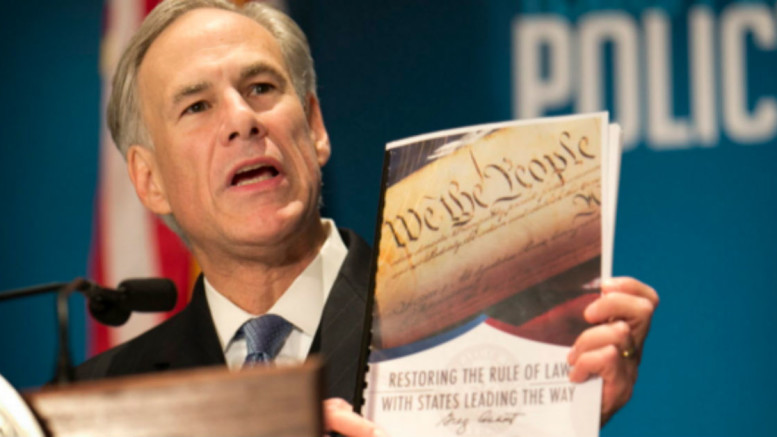Texas Has a Plan
Proposals for a “convention of the states” roil the Left and Right.
Texas Governor Greg Abbott made news early this month when he advocated an Article V convention of states to amend the U.S. Constitution to rein in the overreaching federal government, and restore the proper balance of power between the states and the federal government.This ambitious proposal, which he dubbed the “Texas Plan,” was unveiled at a keynote address to a receptive audience attending a meeting of the Austin-based Texas Public Policy Foundation. The foundation is a conservative think tank with ties to Abbott’s predecessor, Governor Rick Perry, who expressed similar sentiments in his 2010 book Fed Up! (described by the New York Times as “a Tea Party manifesto”), ahead of his unsuccessful presidential bid in 2012.
Abbott’s speech was accompanied by the release of an impressive 92-page document entitled Restoring the Rule of Law: With States Leading the Way, containing 353 footnotes. The initiative is not a frivolous exercise; it reflects considerable effort and seems calculated to make Abbott a national political figure. He called on the Texas legislature (not again in session until 2017) to support a convention of states to propose a number of amendments to the U.S. Constitution. Maintaining that the federal government has—with the complicity of Congress, the executive branch, and the federal judiciary—exceeded the limits intended by the Founding Fathers, Abbott suggested nine constitutional amendments.
These amendments (reproduced here verbatim) would:
- Prohibit Congress from regulating activity that occurs wholly within one State.
- Require Congress to balance its budget.
- Prohibit administrative agencies—and the unelected bureaucrats that staff them—from creating federal law.
- Prohibit administrative agencies—and the unelected bureaucrats that staff them—from preempting state law.
- Allow a two-thirds majority of the States to override a U.S. Supreme Court decision.
- Require a seven-justice super-majority vote for U.S. Supreme Court decisions that invalidate a democratically-enacted law.
- Restore the balance of power between the federal and state governments by limiting the former to the powers expressly delegated to it in the Constitution.
- Give state officials the power to sue in federal court when federal officials overstep their bounds.
- Allow a two-thirds majority of the States to override a federal law or regulation.
These proposed amendments, Abbott emphasized, are not necessary because the Constitution is flawed or “broken,” but because essential provisions of it have been disregarded by all three branches of the federal government. By straying from the enumerated powers, and ignoring the system of checks and balances contained in the Constitution as written, “the government’s flagrant and repeated violations of the rule of law amount to a wholesale abdication of the Constitution’s design.” The solution, Abbott declared, is to adopt amendments that explicitly limit the various branches to their intended roles: “The Texas Plan is not so much a vision to alter the Constitution as it is a call to restore the rule of our current one.” The 92-page supporting document explains the background and justification for each of the proposed amendments in considerable detail.
Substantively, the nine amendments address familiar (and legitimate) concerns about overly broad interpretations of Congress’s Commerce Clause authority; the proliferation of administrative agencies with rulemaking authority scarcely subject to judicial review under the Chevron doctrine; huge amounts of debt accumulated by federal deficit spending; activist decision making by the U.S. Supreme Court; and disregard of state sovereignty by the federal government (and especially by agencies such as the EPA) in violation of the 10th Amendment. To cite just one recent example, Senator Mike Lee (R-UT) wrote a thoughtful book, Our Lost Constitution: The Willful Subversion of America’s Founding Document voicing many of these concerns (which Keith Whittington reviewed on this site). In fact President Obama’s lawless administration has spawned an entire scholarly literature highlighting the extent of the problem.
Alas, when it comes to the Constitution, identifying the problem is the easy part; solving it is much more difficult. Article V intentionally makes amending the Constitution a laborious task, requiring ratification by three-fourths of the states (explaining why only 27 amendments have been adopted since 1789). Thus, Abbott’s call for nine more amendments, to be proposed at a “convention of states” has been met with skepticism, and very little support. Here’s why.
A convention of the states is permitted but has never been used. And contemplating so many substantive amendments to our founding charter of government only adds to how deeply controversial such a project is. Abbott’s proposal drew immediate notice—mostly negative—from all points on the political spectrum. Liberals will vociferously oppose amendments to correct “progressive” policy outcomes, as evidenced by the longstanding resistance to a balanced budget amendment (one of Abbott’s proposals). For this reason, a laundry list of proposed constitutional amendments to overturn the status quo is DOA.
Hundreds of comments by the Left-leaning readers of the Texas Tribune were harshly critical of Abbott and his motives. Accusing the Governor of unwarranted antipathy toward President Obama, the liberal Austin American-Statesman denounced the plan, terming it “Abbott’s fix for what isn’t broken.” Writing in The Washington Post, Catherine Rampell disingenuously accused Abbott (and other proponents of a constitutional convention, such as Sen. Marco Rubio (R-FL)), of hypocrisy for professing reverence for the Constitution, while simultaneously trying “to revamp it completely.” In an essay for ThinkProgress.org, Ian Millhiser set a tone bordering on hysterical, declaring that Abbott’s proposed amendments, if adopted, “would be akin to throwing out the system of government established by the Constitutional Convention of 1787.” The title of his piece summarized his sentiment exactly: “Texas Governor Unveils Plan to Repeal the 20th Century.”
At the same time, others on the Left, such as University of Texas law professor Sanford Levinson, strongly support amending the Constitution (which they find antiquated), and wholeheartedly support a national conversation on the topic, even though Levinson disagrees with Abbott “on what the particular defects of the Constitution are.” The Left cannot abide the Constitution as written, and would love to revise it. This explains why many on the Right, including self-proclaimed “constitutionalists” and Tea Party-types, adamantly oppose an Article V convention of the states. Phyllis Schlafly has long condemned calls for a constitutional convention as “playing Russian Roulette with our Constitution.” The fear is that, once a convention were convened, it would be be hijacked by liberal special interests who would gut the provisions revered by conservatives (for example the Second Amendment, the Electoral College, equal representation of states in the Senate), and pass amendments to repeal the Supreme Court’s 2010 decision in Citizens United, create a right to a “living wage” and similar entitlements, and eliminate religious liberties.
Article V is bereft of any procedural rules limiting the agenda of a convention to proposals submitted in advance. The risk of a “runaway” convention is real. The Constitutional Convention of 1787 produced a document that went far beyond what the 13 original states anticipated. If a “convention of the states” was convened, Justice Antonin Scalia has tersely warned, “Who knows what would come out of it?” Libertarian legal commentator Walter Olson vividly described Abbott’s proposal as the constitutional equivalent of Wile E. Coyote ordering a product from ACME Corporation to catch the elusive Road Runner: “If it doesn’t just sit there doing nothing, it’s apt to blow up on the spot.”
Conservatives and classical liberals are understandably frustrated by the Supreme Court’s misinterpretation of the U.S. Constitution, Congress’s fiscal irresponsibility and delegation of lawmaking authority to administrative agencies, and the creation of a federal Leviathan. As a nation, we need to have a candid discussion about the extent to which the current dysfunction in Washington is due to abandonment of safeguards and limits the Framers put in place to prevent the behemoth the federal government has become. Our political leaders have failed us, not the Constitution. Perhaps this well-intentioned proposal can help provoke such a discussion. Realistically, however, 34 states will never support a constitutional convention, and even if they did—and adopted these nine amendments—it is barely conceivable that three-fourths of the states (38) would ratify them.
A “convention of the states” is a fanciful, impractical, even Rube Goldberg-like-scheme that could indeed result in an open-ended convention whose decisions made the problem worse. Rather, the ultimate solution to our current dilemma lies in the election of a conservative President and a principled U.S. Senate, who would appoint and confirm a majority of sound, committed originalists to the U.S. Supreme Court. We don’t need to amend the Constitution. We need to enforce it. Our nation has been led astray by feckless legislators and progressive jurists who for generations have failed to follow the Constitution that was ratified in 1789. It is time for voters to restore the Constitution, at the ballot box, by insisting on constitutionalists–elected officials who will respect the Constitution and the rule of law. Benjamin Franklin eloquently described our constitutional system as “A republic, if you can keep it.” His challenge is timeless.

